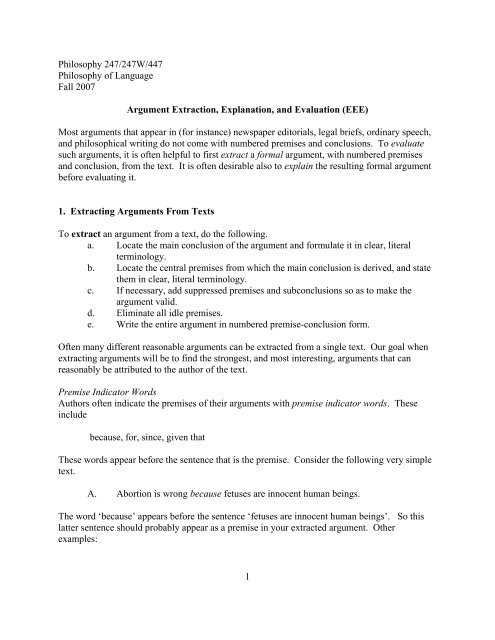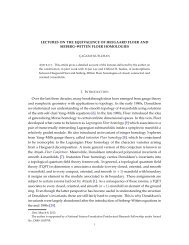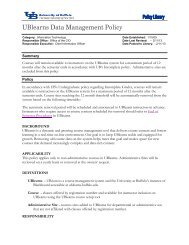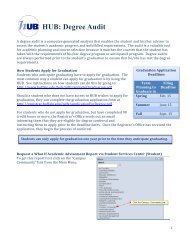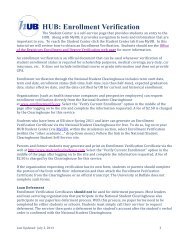Extraction, Explanation, and Evaluation of Arguments Handout
Extraction, Explanation, and Evaluation of Arguments Handout
Extraction, Explanation, and Evaluation of Arguments Handout
- No tags were found...
You also want an ePaper? Increase the reach of your titles
YUMPU automatically turns print PDFs into web optimized ePapers that Google loves.
Philosophy 247/247W/447Philosophy <strong>of</strong> LanguageFall 2007Argument <strong>Extraction</strong>, <strong>Explanation</strong>, <strong>and</strong> <strong>Evaluation</strong> (EEE)Most arguments that appear in (for instance) newspaper editorials, legal briefs, ordinary speech,<strong>and</strong> philosophical writing do not come with numbered premises <strong>and</strong> conclusions. To evaluatesuch arguments, it is <strong>of</strong>ten helpful to first extract a formal argument, with numbered premises<strong>and</strong> conclusion, from the text. It is <strong>of</strong>ten desirable also to explain the resulting formal argumentbefore evaluating it.1. Extracting <strong>Arguments</strong> From TextsTo extract an argument from a text, do the following.a. Locate the main conclusion <strong>of</strong> the argument <strong>and</strong> formulate it in clear, literalterminology.b. Locate the central premises from which the main conclusion is derived, <strong>and</strong> statethem in clear, literal terminology.c. If necessary, add suppressed premises <strong>and</strong> subconclusions so as to make theargument valid.d. Eliminate all idle premises.e. Write the entire argument in numbered premise-conclusion form.Often many different reasonable arguments can be extracted from a single text. Our goal whenextracting arguments will be to find the strongest, <strong>and</strong> most interesting, arguments that canreasonably be attributed to the author <strong>of</strong> the text.Premise Indicator WordsAuthors <strong>of</strong>ten indicate the premises <strong>of</strong> their arguments with premise indicator words. Theseincludebecause, for, since, given thatThese words appear before the sentence that is the premise. Consider the following very simpletext.A. Abortion is wrong because fetuses are innocent human beings.The word ‘because’ appears before the sentence ‘fetuses are innocent human beings’. So thislatter sentence should probably appear as a premise in your extracted argument. Otherexamples:1
B . Since fetuses are innocent human beings, taking their lives is morally wrong.C. Meanings are clearly mental in nature, for human minds grasp the meanings <strong>of</strong>words.Conclusion Indicator WordsSome words indicate a conclusion in the text, including:so, therefore, thus, hence, it follows that, consequentlyThe sentences that appear after these words are conclusions (or subconclusions) <strong>of</strong> arguments.D. Fetuses are innocent human beings, so abortion is wrong. (Compare with (A)above.)E. Words in English are meaningful. It follows that those words have meanings.F. No telescope, microscope, X-ray machine, PET scan, or MRI has ever revealedthe presence <strong>of</strong> a meaning anywhere. Hence, there are no such things asmeanings.Adding premises to obtain a valid argumentThe extracted argument should be valid: that is, each simple argument in it should be valid. Anargument that is invalid can <strong>of</strong>ten be transformed into a valid argument that the author wouldaccept by adding a conditional premise. For instance, consider the simple text (G) below.G. Hillary is a U.S. Senator. So, even an idiot can see that she is a federal employee.When extracting a numbered-premise-<strong>and</strong>-conclusion argument from (G), we leave out theunnecessary rhetoric. As a first step we get (H) below.H. 1. Hillary is a U.S. Senator.2. Therefore, Hillary is a federal employeeThis argument is invalid. But it can be transformed into a valid argument by adding aconditional premise to get argument (I).I. 1. Hillary is a U.S. Senator.2. If Hillary is a U.S. Senator, then Hillary is a federal employee.3. Therefore, Hillary is a federal employee.Further, the added premise is almost certainly one that the author would accept.2
Idle premisesThe arguments you extract from texts should have no idle premises. Informally speaking, an idlepremise is one that plays no role in supporting the conclusion <strong>of</strong> the argument in which itappears. A bit more precisely:Def.S is an idle premise in A iff: A is a valid argument, S is a premise in A, <strong>and</strong> theargument obtained by deleting S from A is valid.For example, sentence (3) in argument (J) is an idle premise in (J).J. 1. Hillary is a U.S. Senator.2. If Hillary is a U.S. Senator, then Hillary is a federal employee.3. Hillary receives a check from the U.S. Treasury Department every week.4. Therefore, Hillary is a federal employee.An even more obvious case <strong>of</strong> an idle premise is line (3) in (K).K. 1. Hillary is a U.S. Senator.2. If Hillary is a U.S. Senator, then Hillary is a federal employee.3. Snow is red.4. Therefore, Hillary is a federal employee.Notice that argument (K) is unsound because line (3) is false. Idle premises are bad because theydo nothing to support the argument’s conclusion, yet they increase the risk that the argument isunsound.2. Explaining An Extracted ArgumentTo explain an argument that you have extracted, do the following.a. Define all the technical terms that appear in the argument.b. Give reasons for each <strong>of</strong> the premises <strong>of</strong> the argument line by line. (Do not givereasons for the main conclusion <strong>and</strong> subconclusions.) In some cases, the author’stext provides reasons to believe the premise. In other cases, you must providereasons which would lead a reasonable person to accept the premise. Theseshould be consistent with the other premises <strong>of</strong> the argument, <strong>and</strong> preferablyreasons that you think the author would accept.You may define technical terms in your line-by-line explanation <strong>of</strong> the premises, if you wish.Sometimes an author will give reasons for a premise which, if they were included in the formalnumbered argument, will make the argument impractically long. In this case, you can presentwhat you take to be the main reasons for the conclusion in the numbered premises <strong>and</strong> put thesubsidiary reasons in the explanation. In cases where your extracted argument contains a3
premise for which the author provides no reason, you should consider the reasons that you canthink <strong>of</strong> for accepting it <strong>and</strong> present those in the explanation.You should not explain the conclusions <strong>and</strong> subconclusions <strong>of</strong> arguments. If the argument isvalid, <strong>and</strong> the premises are true, then the conclusions <strong>and</strong> subconclusions must also be true. Thetechnical terms that appear in conclusions <strong>and</strong> subconclusions <strong>of</strong> valid arguments appear in thepremises <strong>of</strong> those arguments (with the exception <strong>of</strong> some oddball arguments), so you shouldhave already defined those terms when you explained the premises.3. Evaluating An Extracted ArgumentTo evaluate an argument that you have extracted <strong>and</strong> explained, do the following.a. State whether each simple argument is valid or invalid. If the argument iscomplex, then for each simple argument in it, state whether that simple argumentis valid. (If you extracted the argument correctly, each simple argument will bevalid.)b. For each simple argument that is valid, state the name <strong>of</strong> the logical form that itexemplifies (MP, MT, etc.).c. State whether the argument is sound.d. If the argument has one or more premises that are false or controversial, point outthe weakest such premise <strong>and</strong> criticize it (present some objection to it). Be sure tospecify which premise you are criticizing.I will usually ask you to state a reasonable objection to the argument, even if you think that it issound. Sometimes, I will ask you to describe how the author might respond to the criticism youpresent in (d).4
Sample Texts for EEE1. Philosophers who accept the referential theory <strong>of</strong> meaning say that the meaning <strong>of</strong> a word isthe thing it refers to. But that’s just silly. The word ‘the’ has a meaning–it’s not just ameaningless sound. But just try pointing at the thing that it refers to! Obviously, ‘the’ doesn’trefer to anything. Those referentialists need to learn a little common sense.2. When George uttered the sentence ‘Pegasus does not exist’, he used the name ‘Pegasus’ torefer to Pegasus. (What else would he be referring to? Bill Clinton, maybe?) But if he referredto Pegasus, then there must be a Pegasus. So Pegasus must exist.3. Anyone who puts aside his prejudices <strong>and</strong> just thinks for a minute will realize that there arenonexistent objects. Look, obviously Homer Simpson, Santa Claus, <strong>and</strong> Huckleberry Finn arethings don’t exist. So, there are things that don’t exist, <strong>and</strong> so there are nonexistent objects.Yes, Virginia, there is a Santa Claus, only he doesn’t exist.4. If meanings are ideas, then all we ever talk about are our own ideas. How stupid is that?5


